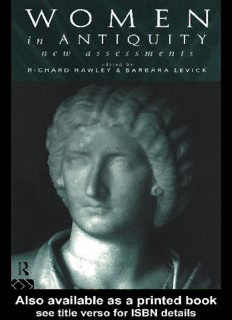
Women in Antiquity: New Assessments PDF
Preview Women in Antiquity: New Assessments
Women in antiquity: new assessments The study of gender in classical antiquity has undergone rapid and wide-ranging development in the past two decades. This collection of new assessments has been written by some of the most influential experts in this field from all over the world. The contributors reassess the role of women in diverse contexts and areas, such as archaic and classical Greek literature and cult, Roman imperial politics, ancient medicine and early Christianity. Some offer original interpretations of topics which have been widely discussed over the last twenty years; others highlight new areas of research. Women in Antiquity: New Assessments reflects and expands on existing scholarly debates on the status and representation of women in the ancient world. It focuses on methodology, and suggests areas for research and improvement. It is invaluable and engaging reading for all students and teachers of ancient history. Richard Hawley is a Lecturer in Classics at Royal Holloway College, University of London. Barbara Levick is a Fellow of St Hilda’s College, Oxford. Women in antiquity New assessments Edited by Richard Hawley and Barbara Levick London and New York First published 1995 by Routledge 11 New Fetter Lane, London EC4P 4EE This edition published in the Taylor & Francis e-Library, 2004. Simultaneously published in the USA and Canada by Routledge 29 West 35th Street, New York, NY 10001 Selection and editorial matter © 1995 Richard Hawley and Barbara Levick Individual chapters © 1995 the contributors All rights reserved. No part of this book may be reprinted or reproduced or utilized in any form or by any electronic, mechanical, or other means, now known or hereafter invented, including photocopying and recording, or in any information storage or retrieval system, without permission in writing from the publishers. British Library Cataloguing in Publication Data A catalogue record for this book is available from the British Library Library of Congress Cataloguing in Publication Data A catalogue record for this book has been requested ISBN 0-203-42855-2 Master e-book ISBN ISBN 0-203-73679-6 (Adobe eReader Format) ISBN 0-415-11368-7 (Print Edition) 0-415-11369-5 (pbk) Contents List of plates vii List of figures viii List of tables ix List of journal abbreviations x Preface xiii Notes on contributors xvi 1 From ‘daily life’ to ‘demography’ 1 Beryl Rawson 2 Ideology and ‘the status of women’ in ancient Greece 21 Marilyn A.Katz 3 Approaching women through myth: vital tool or self-delusion? 44 Ken Dowden 4 Signifying difference: the myth of Pandora 58 Froma I.Zeitlin 5 The cults of Demeter and Kore 75 Lucia Nixon 6 Women’s ritual and men’s work in ancient Athens 97 Lin Foxhall 7 Women’s identity and the family in the classical polis 111 Sarah B.Pomeroy 8 Some Pythagorean female virtues 122 Voula Lambropoulou vi Contents 9 Self-help, self-knowledge: in search of the patient in Hippocratic gynaecology 135 Helen King 10 Women who suffer from a man’s disease: the example of satyriasis and the debate on affections specific to the sexes 149 Danielle Gourevitch 11 Re-reading (Vestal) virginity 166 Mary Beard 12 Male power and legitimacy through women: the domus Augusta under the Julio-Claudians 178 Mireille Corbier 13 Women and elections in Pompeii 194 Liisa Savunen 14 A woman’s voice—Laronia’s role in Juvenal Satire 2 207 S.H.Braund 15 Aemilia Pudentilla: or the wealthy widow’s choice 220 Elaine Fantham 16 Female sanctity in the Greek calendar: the Synaxarion of Constantinople 233 Anna Wilson Select bibliography 248 Index 265 Plates 1.1 Stele of brother and sister Mnesagora and Nikochares, c. 420–410 BC 5 1.2 Stele of grandmother Ampharete and infant, late fifth century BC 6 1.3 Altar, Iunia Venusta and familia, late first-early second century AD 7 1.4 Epigraph of a mother, Gauia Chrysis, first-second century AD, from Rome 8 1.5a Cleopatra and son Caesarion as Isis and Hathor, Temple of Hathor, Dendera, Upper Egypt, first century BC 14 1.5b Cleopatra on Roman coin, Alexandria 32–31 BC, as Queen of Kings 15 1.6 Roman coin of Sabina Augusta, wife of Emperor Hadrian, AD 128–138; reverse has Pietas and children 15 1.7 Thomas Couture, Les romains et leur décadence, 1847 17 Figures 5.1 Eleusis, plan of the sanctuary and city 79 5.2 Bitalemi/Gela, plan of the sanctuary 80 5.3 Corinth, plan of the sanctuary of Demeter and Kore, c. 400 BC 81 5.4 Priene, plan of the sanctuary of Demeter and Kore 83 12.1 The respective descendants of Augustus and Livia 180 12.2 Descendants of Octavia I, sister of Augustus 181 12.3 The agnatic descendants of Augustus by natural or adoptive filiation 183 12.4 Kinship between Nero Caesar and his wife Julia 185 12.5 Kinship between Nero and his wife Octavia II 189 Tables 6.1 Agricultural jobs and festivals in Attica 98–9 16.1 Main entries by gender and type for September and October 235 16.2 Number of women heading all-female main entries 237 16.3 Number of women jointly heading mixed entries 237 16.4 Categories of women mentioned in subordinate roles in the summaries 238 16.5 Information on social status of women mentioned in the Synaxarion 240
Description: